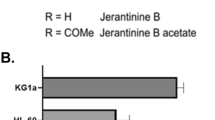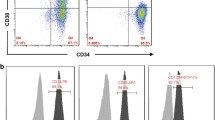Abstract
Acute myeloid leukemia is a heterogeneous disease with varying genetic and molecular pathologies. Non-steroidal anti-inflammatory drugs (NSAIDs) have been proven to possess significant anti-proliferative potential in various cancer cells in vitro and in vivo. Hence, treatment with these agents can be utilized to study disease specific anti-proliferative pathways. In this study, a total number of 42 bone marrow derived CD34+ selected de novo AML patient samples and the AML cell lines THP-1 and HL-60 were treated with the NSAIDs Sulindac sulfide and Diclofenac. We analyzed viability, apoptosis, differentiation and addressed the molecular mechanisms involved. We found a consistent induction of apoptosis and to some extent an increased myeloid differentiation capacity in NSAID treated AML cells. Comprehensive protein and gene expression profiling of Diclofenac treated AML cells revealed transcriptional activation of GADD45α and its downstream MAPK/JNK pathway as well as increased protein levels of the caspase-3 precursor. This pointed towards a role of the c-Jun NH2-terminal kinase (JNK) in NSAID mediated apoptosis that we found indeed to be dependent on JNK activity as addition of a specific JNK-inhibitor abrogated apoptosis. Furthermore, the AP-1 transcription factor family members’ c-Jun, JunB and Fra-2 were transcriptionally activated in NSAID treated AML cells and re-expression of these transcription factors led to activation of GADD45α with induction of apoptosis. Mechanistically, we demonstrate that NSAIDs induce apoptosis in AML through a novel pathway involving increased expression of AP-1 heterodimers, which by itself is sufficient to induce GADD45α expression with consecutive activation of JNK and induction of apoptosis.






Similar content being viewed by others
References
Löwenberg B, Downing JR, Burnett A (1999) Acute myeloid leukemia. N Engl J Med 341(14):1051–1062
Grimwade D, Hills RK (2009) Independent prognostic factors for AML outcome. Hematol Am Soc Hematol Educ Program 385–95
Vardiman JW, Thiele J, Arber DA, Brunning RD, Borowitz MJ, Porwit A, Harris NL, Le Beau MM, Hellström-Lindberg E, Tefferi A, Bloomfield CD (2009) The 2008 revision of the World Health Organization (WHO) classification of myeloid neoplasms and acute leukemia: rationale and important changes. Blood 114(5):937–951
Yang BX, Duan YJ, Dong CY, Zhang F, Gao WF, Cui XY, Lin YM, Ma XT (2011) Novel functions for mda-7/IL-24 and IL-24 delE5: regulation of differentiation of acute myeloid leukemic cells. Mol Cancer Ther 10(4):615–625
Halazonetis TD, Gorgoulis VG, Bartek J (2008) An oncogene-induced DNA damage model for cancer development. Science 319(5868):1352–1355
Krause A, Luciana M, Krause F, Rego EM (2010) Targeting the acute myeloid leukemia stem cells. Anticancer Agents Med Chem 10(2):104–110
Sarkar D, Su ZZ, Lebedeva IV, Sauane M, Gopalkrishnan RV, Valerie K, Dent P, Fisher PB (2002) Mda-7 (IL-24) mediates selective apoptosis in human melanoma cells by inducing the coordinated overexpression of the GADD family of genes by means of p38 MAPK. Proc Natl Acad Sci USA 99(15):10054–10059
Gupta P, Walter MR, Su ZZ, Lebedeva IV, Emdad L, Randolph A, Valerie K, Sarkar D, Fisher PB (2006) BiP/GRP78 is an intracellular target for MDA-7/IL-24 induction of cancer-specific apoptosis. Cancer Res 66(16):8182–8191
Sauane M, Su ZZ, Gupta P, Lebedeva IV, Dent P, Sarkar D, Fisher PB (2008) Autocrine regulation of mda-7/IL-24 mediates cancer-specific apoptosis. Proc Natl Acad Sci USA 105(28):9763–9768
Rahmani M, Mayo M, Dash R, Sokhi UK, Dmitriev IP, Sarkar D, Dent P, Curiel DT, Fisher PB, Grant S (2010) Melanoma differentiation associated gene-7/interleukin-24 potently induces apoptosis in human myeloid leukemia cells through a process regulated by endoplasmic reticulum stress. Mol Pharmacol 78(6):1096–1104
Zerbini LF, Czibere A, Wang Y, Correa RG, Otu H, Joseph M, Takayasu Y, Silver M, Gu X, Ruchusatsawat K, Li L, Sarkar D et al (2006) A novel pathway involving melanoma differentiation associated gene-7/interleukin-24 mediates nonsteroidal anti-inflammatory drug-induced apoptosis and growth arrest of cancer cells. Cancer Res 66(24):11922–11931
Suh YJ, Chada S, McKenzie T, Liu Y, Swisher SG, Lucci A, Hunt KK (2005) Synergistic tumoricidal effect between celecoxib and adenoviral-mediated delivery of mda-7 in human breast cancer cells. Surgery 138(3):422–430
Oida Y, Gopalan B, Miyahara R, Inoue S, Branch CD, Mhashilkar AM, Lin E, Bekele BN, Roth JA, Chada S, Ramesh R (2005) Sulindac enhances adenoviral vector expressing mda-7/IL-24-mediated apoptosis in human lung cancer. Mol Cancer Ther 4(2):291–304
Czibere A, Prall WC, Zerbini LF, Grall F, Craigie EC, Ulrich SD, Giagounidis AA, Haas R, Libermann TA, Aivado M (2005) The nonsteroidal anti-inflammatory drug Exisulind selectively induces apoptosis via JNK in secondary acute myeloid leukemia after myelodysplastic syndrome. Cell Cycle 4(6):812–817
Lehr S, Kotzka J, Avci H, Knebel B, Muller S, Hanisch FG, Jacob S, Haak C, Susanto F, Muller-Wieland D (2005) Effect of sterol regulatory element binding protein-1a on the mitochondrial protein pattern in human liver cells detected by 2D-DIGE. Biochemistry 44(13):5117–5128
Tews D, Lehr S, Hartwig S, Osmers A, Passlack W, Eckel J (2009) Anti-apoptotic action of exendin-4 in INS-1 beta cells: comparative protein pattern analysis of isolated mitochondria. Horm Metab Res 41(4):294–301
Rabilloud T, Strub JM, Luche S, van Dorsselaer A, Lunardi J (2001) Comparison between sypro ruby and ruthenium II tris (bathophenanthroline disulfonate) as fluorescent stains for protein detection in gels. Proteomics 1:699–704
Li C, Wong WH (2001) Model-based analysis of oligonucleotide arrays: expression index computation and outlier detection. Proc Natl Acad Sci USA 98(1):31–36
Yuen T, Wurmbach E, Pfeffer RL, Ebersole BJ, Sealfon SC (2002) Accuracy and calibration of commercial oligonucleotide and custom cDNA microarrays. Nucleic Acids Res 30(10):e48
Zerbini LF, Wang Y, Czibere A, Correa RG, Cho JY, Ijiri K, Wei W, Joseph M, Gu X, Grall F, Goldring MB, Zhou JR et al (2004) NF-kappa B-mediated repression of growth arrest- and DNA-damage-inducible proteins 45alpha and gamma is essential for cancer cell survival. Proc Natl Acad Sci USA 101(37):13618–13623
Rothwell PM, Fowkes FG, Belch JF, Ogawa H, Warlow CP, Meade TW (2011) Effect of daily aspirin on long-term risk of death due to cancer: analysis of individual patient data from randomised trials. Lancet 377(9759):31–41
Hahn E, Kraus S, Arber N (2010) Role of cyclooxygenase-2 in pathogenesis and prevention of colorectal cancer. Dig Dis 28(4–5):585–589
Wu CY, Wu MS, Kuo KN, Wang CB, Chen YJ, Lin JT (2010) Effective reduction of gastric cancer risk with regular use of nonsteroidal anti-inflammatory drugs in Helicobacter pylori-infected patients. J Clin Oncol 28(18):2952–2957
Czibere A, Prall WC, Zerbini LF, Jäger M, Kobbe G, Knipp S, Libermann TA, Haas R, Aivado M (2006) Exisulind induces apoptosis in advanced myelodysplastic syndrome (MDS) and acute myeloid leukaemia/MDS. Br J Haematol 135(3):355–357
Larbi NB, Jefferies C (2009) 2D-DIGE: comparative proteomics of cellular signalling pathways. Methods Mol Biol 517:105–132
Lu J, Lal A, Merriman B, Nelson S, Riggins G (2004) A comparison of gene expression profiles produced by SAGE, long SAGE, and oligonucleotide chips. Genomics 84(4):631–636
Senthivinayagam S, Mishra P, Paramasivam SK, Yallapragada S, Chatterjee M, Wong L, Rana A, Rana B (2009) Caspase-mediated cleavage of beta-catenin precedes drug-induced apoptosis in resistant cancer cells. J Biol Chem 284(20):13577–13588
Zhang B, Zhang Y, Shacter E (2003) Caspase 3-mediated inactivation of rac GTPases promotes drug-induced apoptosis in human lymphoma cells. Mol Cell Biol 23(16):5716–5725
Friedrich K, Wieder T, Von Haefen C, Radetzki S, Jänicke R, Schulze-Osthoff K, Dörken B, Daniel PT (2001) Overexpression of caspase-3 restores sensitivity for drug-induced apoptosis in breast cancer cell lines with acquired drug resistance. Oncogene 20(22):2749–2760
Blanc C, Deveraux QL, Krajewski S, Jänicke RU, Porter AG, Reed JC, Jaggi R, Marti A (2000) Caspase-3 is essential for procaspase-9 processing and cisplatin-induced apoptosis of MCF-7 breast cancer cells. Cancer Res 60(16):4386–4390
Rebillard A, Jouan-Lanhouet S, Jouan E, Legembre P, Pizon M, Sergent O, Gilot D, Tekpli X, Lagadic-Gossmann D, Dimanche-Boitrel MT (2010) Cisplatin-induced apoptosis involves a Fas-ROCK-ezrin-dependent actin remodelling in human colon cancer cells. Eur J Cancer 46(8):1445–1455
Grzanka A, Grzanka D, Orlikowska M (2003) Cytoskeletal reorganization during process of apoptosis induced by cytostatic drugs in K-562 and HL-60 leukemia cell lines. Biochem Pharmacol 66(8):1611–1617
Launay S, Brown G, Machesky LM (2003) Expression of WASP and Scar1/WAVE1 actin-associated proteins is differentially modulated during differentiation of HL-60 cells. Cell Motil Cytoskelet 54(4):274–285
Cohen DM and Chen CS (2008) Mechanical control of stem cell differentiation. StemBook, ed The Stem Cell Research Community, StemBook. doi:10.3824/stembook.1.26.1, http://www.stembook.org
Johnson GL, Lapadat R (2002) Mitogen-activated protein kinase pathways mediated by ERK, JNK, and p38 protein kinases. Science 298(5600):1911–1912
Takada E, Hata K, Mizuguchi J (2008) c-Jun NH2-terminal kinase (JNK)-dependent nuclear translocation of apoptosis-inducing factor (AIF) following engagement of membrane immunoglobulin on WEHI-231 B lymphoma cells. J Cell Biochem 104(5):1927–1936
Tournier C, Hess P, Yang DD, Xu J, Turner TK, Nimnual A, Bar-Sagi D, Jones SN, Flavell RA, Davis RJ (2000) Requirement of JNK for stress-induced activation of the cytochrome c-mediated death pathway. Science 288(5467):870–874
Yin F, Bruemmer D, Blaschke F, Hsueh WA, Law RE, Herle AJ (2004) Signaling pathways involved in induction of GADD45 gene expression and apoptosis by troglitazone in human MCF-7 breast carcinoma cells. Oncogene 23(26):4614–4623
Takekawa M, Saito H (1998) A family of stress-inducible GADD45-like proteins mediate activation of the stress-responsive MTK1/MEKK4 MAPKKK. Cell 95(4):521–530
Steidl U, Rosenbauer F, Verhaak RG, Gu X, Ebralidze A, Otu HH, Klippel S, Steidl C, Bruns I, Costa DB, Wagner K, Aivado M et al (2006) Essential role of Jun family transcription factors in PU.1 knockdown-induced leukemic stem cells. Nat Genet 38(11):1269–1277
Shaulian E (2010) AP-1—the Jun proteins: oncogenes or tumor suppressors in disguise? Cell Signal 22(6):894–899
Hess J, Angel P, Schorpp-Kistner M (2004) AP-1 subunits: quarrel and harmony among siblings. J Cell Sci 117(Pt 25):5965–5973
Acknowledgments
We would like to thank Annemarie Koch and Waltraud Passlack for excellent technical assistance. A.C. and I.B. are supported by grants from Leukämie Liga e.V. Düsseldorf, Germany and the Forschungskommission of the Heinrich-Heine-University, Düsseldorf, Germany. A.C. is further supported by the Deutsche Krebshilfe through a Dr. Mildred Scheel fellowship award and by a research fellowship award from the European Association of Hematology (EHA). L.F.Z is supported by Department of Defense grants PC051217 and OC0060439.
Author information
Authors and Affiliations
Corresponding author
Electronic supplementary material
Below is the link to the electronic supplementary material.
Rights and permissions
About this article
Cite this article
Singh, R., Cadeddu, RP., Fröbel, J. et al. The non-steroidal anti-inflammatory drugs Sulindac sulfide and Diclofenac induce apoptosis and differentiation in human acute myeloid leukemia cells through an AP-1 dependent pathway. Apoptosis 16, 889–901 (2011). https://doi.org/10.1007/s10495-011-0624-y
Published:
Issue Date:
DOI: https://doi.org/10.1007/s10495-011-0624-y




